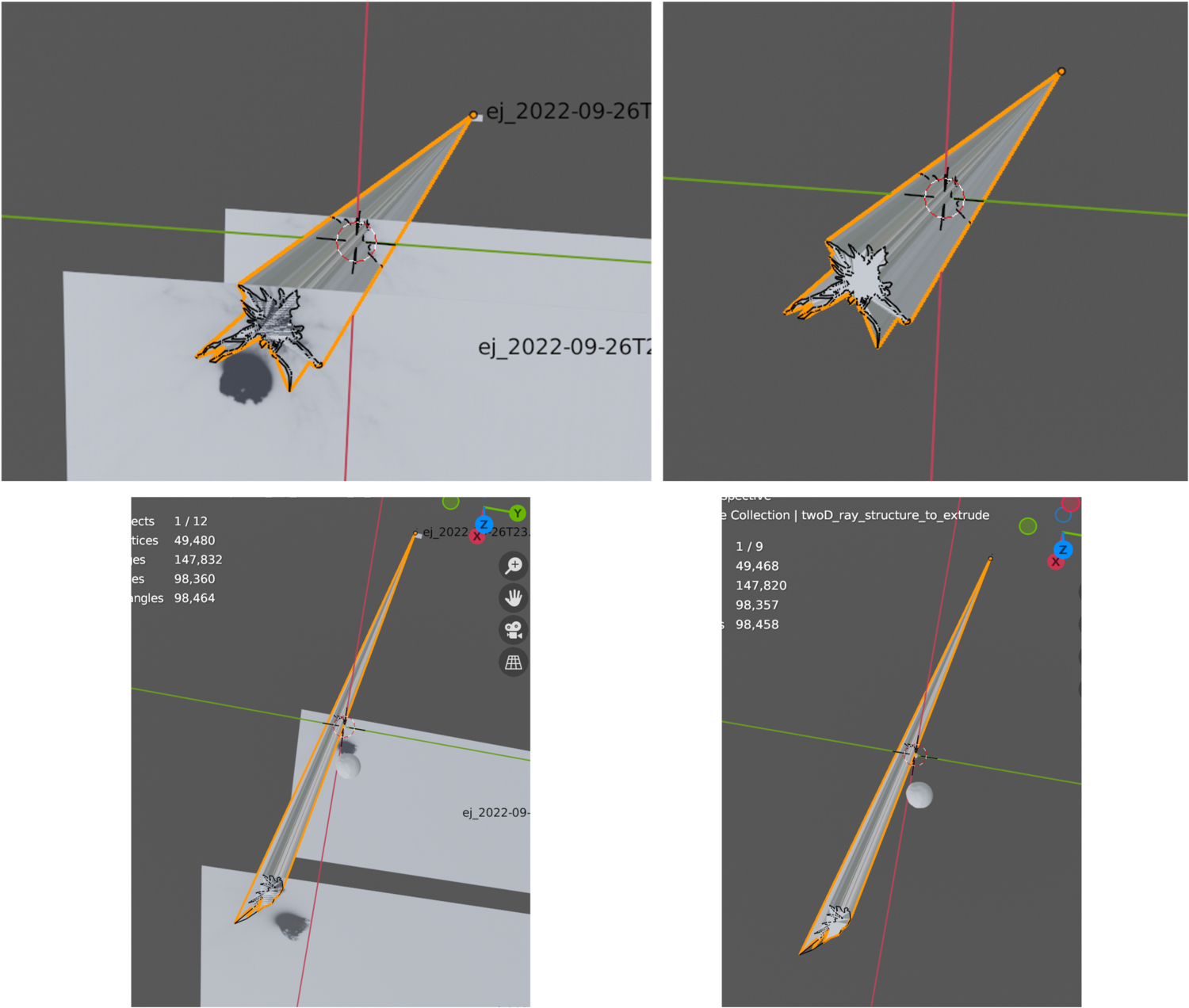Reconstruction of Ejecta Shape from LICIACube Data
- 1INAF - Osservatorio Astronomico di Roma, Monte Porzio Catone, Italy (prasanna.deshapriya@inaf.it)
- 2Università di Bologna, Bologna, Italy
- *A full list of authors appears at the end of the abstract
The NASA DART mission impacted the asteroid Dimorphos, the satellite of the asteroid Didymos, at 23:14 UTC on September 26, 2022, as a planetary defense test. This marked the first hypervelocity impact experiment on an asteroid relevant to planetary defense. The Italian Space Agency's LICIACube captured crucial imagery before and after the impact, aiding in studying the ejecta's distribution in inertial space. The data returned by LUKE camera aboard LICIACube thus enabled the characterisation of the orientation and geometry of resultant ejecta [1,2,3], which are closely related to the calculation of how effective the impact has been in imparting momentum to the asteroid (parameter β) [4].
LUKE images acquired at different vantage points with respect to the ejecta, allowed the characterisation of the global ejecta structured in the aforementioned studies, by approximating it to a hollow cone. Nevertheless, the real structure of the ejecta is intricate and contains complex structures. Given the availability of LUKE images, we attempt to recover the three-dimensional structure of the ejecta by coregistering them to a Dimorphos-centred coordinate system. We trace two-dimensional ejecta shapes [5] as projected onto LUKE images and then place these 2D shapes (scaled with distance) along LUKE boresight at different distances to create depth so that we capture all the possible theoretical planes where different parts of ejecta structure could reside (Figure 1). Once we obtain such 3D profiles for four different images obtained at various vantage points, we intersect them in an inertial J2000 space. The material common to all the intersections then provides us with a three dimensional structure that is compatible with the images used as input to trace two dimensional profiles on the LUKE images. Then, we bring the resulting structure back to LUKE image space and visualise them with the original images to see how they compare.

Fig.1. Top panel: Left: A perspective view of the three dimensional profile of the ejecta structure recovered using 3 scaled planes (image acquired at '2022-09-26T23:17:03.004' UTC) placed at the location of LICIACube, at the centre of Dimorphos and away from Dimorphos in the same line of sight between LICIACube and Dimorphos. Right: Planes removed to highlight the ejecta structure. Bottom pane: The same for the image acquired at '2022-09-26T23:17:18.000' UTC.
In this way we’re able to validate the three dimensional model we obtained by intersecting three dimensional profiles derived from LUKE images. In order to check its accuracy, the model will be cross-checked against the solutions of Deshapriya et al., 2023 and Hirabayashi et al., 2024 which are compatible with each other. The model will later be refined to remove any resulting artifacts. The result of this work will allow us to understand the three dimensional distribution of ejecta material in inertial space and hence will help constrain models of ejecta propagation following planetary impacts.
Acknowledgments: This research was funded by the Italian National Astrophysical Institute (INAF) - Call for Fundamental Research 2022. The LICIACube team acknowledges financial support from Agenzia Spaziale Italiana (ASI, contract No. 2019-31-HH.0 CUP F84I190012600).
References
[1] Dotto et al., Nature, 627, pages 505–509 (2024)
[2] Hirabayashi et al., submitted to Nature Communications
[3] Deshapriya et al., Planet. Sci. Journal. 4, 231 (2023)
[4] Cheng et al., Nature, 616, 457 (2023)
[5] Zinzi et al., Planet. Sci. Journal. 5, 103 (2024)
Deshapriya, J. D. P. , Hasselmann, P. H. , Gai, I. , Dotto, E. , Rossi, A. , Zinzi, A. , Della Corte, V., Bertini, I. , Ieva, S. , Mazzotta Epifani, E., Dall’Ora, M. , Ivanovski, S. , Perna, D., Bourdelle De Micas, J. , Amoroso, M. , Brucato, J. R., Capannolo, A. , Caporali, S. , Ceresoli, M., Cremonese, G., Casajus, L. Gomez , Gramigna, E. , Impresario, G. , Manghi, R. Lasagni , Lavagna, M., Lombardo, M. , Lucchetti, A. , Modenini, D. , Pajola, M., Palumbo, P. , Pirrotta, S., Poggiali, G., Tortora, P. , Tusberti, F. , Zannoni, M. , Zanotti, G.
How to cite: Deshapriya, J. D. P., Hasselmann, P. H., Gai, I., and Dotto, E. and the LICIACube team: Reconstruction of Ejecta Shape from LICIACube Data, Europlanet Science Congress 2024, Berlin, Germany, 8–13 Sep 2024, EPSC2024-436, https://doi.org/10.5194/epsc2024-436, 2024.